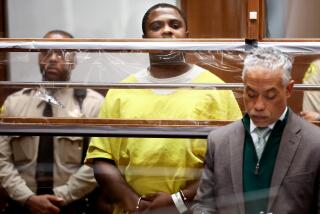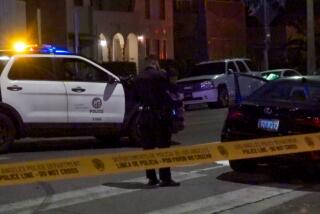2 deaths at Ed Buck’s home and West Hollywood is asking agonizing questions about race and class

Residents of a two-story Laurel Avenue apartment complex in West Hollywood stood on the building’s front porch as dozens of protesters shouted at them.
The residents were mostly white. The protesters were mostly black.
What brought them together in a heated scene Monday night was the troubling, baffling and, for some, deeply infuriating case of longtime Democratic political donor Ed Buck, whose apartment in the building has been the scene of two black men’s apparent overdose deaths in the last two years.
Some protesters turned on Buck’s neighbors, accusing them of being complicit. The neighbors said they were blaming the wrong people.
“If a black man was living there, you wouldn’t be OK with it!” one of the protesters shouted.
Los Angeles County sheriff’s homicide detectives are investigating the death of a 55-year-old man whose body was found just after 1 a.m. Monday in the apartment of Buck, a onetime West Hollywood City Council candidate and well-known figure in LGBTQ political circles. The man, whose name has not been released, died of an apparent overdose, according to Buck’s attorney, Seymour Amster.
Buck, a 64-year-old white man, previously was investigated for the July 2017 death of Gemmel Moore, 26, who died of a methamphetamine overdose in Buck’s apartment, which was littered with drug paraphernalia, according to a Los Angeles County coroner’s report. Prosecutors this summer declined to file charges.
Pictures in the News | Wednesday Jan. 9, 2019 »
In a city known for its activism and protests, the cases have prompted uncomfortable conversations and questions about race, class and drug abuse within the LGBTQ community.
“It says a lot about the dark underbelly of gay culture and West Hollywood,” said Steve Martin, a former West Hollywood city councilman who is gay. “We always are slapping ourselves on the back about how open-minded and diverse we are, and frankly the residents know that’s not always the case. When an incident like this comes up, it makes us confront a lot of issues that are really uncomfortable.”
Some 46% of West Hollywood residents identify as LGBTQ, according to community surveys. The city is 80% white.
Jeffrey King, founder of In the Meantime Men’s Group, a South Los Angeles outreach organization for LGBTQ black men, said he had received dozens of calls this week about the death in Buck’s apartment from frustrated black men who wondered how this could possibly happen again.
“If a young man was found dead in my house, I would have been handcuffed, publicly humiliated in front of my house, in front of my neighbors,” said King, who is black. “They would have placed me in a car, held my head as they lowered me down into the backseat. They would have taken me to the station. … But that did not happen to Ed Buck.”
“Black people are not the only people now who are asking why or how does that happen,” he added. “Ed Buck’s neighbors are asking the same questions.”
Few details are known about the death of the second man. But the Sheriff’s Department said Monday that Buck was present at the time of the death — as he was with Moore’s — and that there will be a secondary review of the Moore case.
Amster said the second man was an “old friend” of Buck who ingested a substance at another location and “came over intoxicated.”
The coroner ruled Moore’s death an accident, and an initial review by sheriff’s deputies found nothing suspicious. But homicide detectives later launched an investigation after Moore’s mother, LaTisha Nixon, and his friends questioned whether the drugs that killed him were self-administered.
Paramedics found Moore naked on a mattress in Buck’s living room, which was littered with drug paraphernalia, according to the coroner’s report. Moore, who was openly gay, had been homeless and had worked as an escort, his family said.
The Los Angeles County district attorney’s office reviewed and rejected four charges: murder, voluntary manslaughter and furnishing and possessing drugs.
Dmitry Gorin, a defense attorney and former deputy district attorney, said there is a high bar to prove someone is culpable in a death involving drugs. Typically, there needs to be a witness who saw the accused administer or furnish the substance that caused death.
“Two people dying from overdose is likely more than a coincidence, but the district attorney needs witnesses and physical evidence to prove a criminal charge beyond a reasonable doubt in court,” Gorin said.
A lesser crime of possession would be easier to prove if prosecutors can show that the drugs belonged to Buck, he said.
Amster said Buck was not arrested in either case and that he is cooperating with authorities.
Jasmyne Cannick, a political consultant who has advocated for Moore’s family and who organized Monday night’s protest, said that “if these were white gay men dead, this would be handled differently.”
She believes Buck has gotten special treatment because of his activism and fundraising for local Democratic candidates, a charge officials have denied. In the past, he has donated money to President Obama, Hillary Clinton, former state Sen. Kevin de León, U.S. Rep. Ted Lieu, West Hollywood city council candidates and other politicians.
“It’s more than race and class,” Cannick said. “It is also political. This is a man protected by the Democratic Party.”
On Tuesday, Lieu said he donated campaign contributions from Buck to LGBTQ and African American advocacy organizations, including GLAAD and the NAACP.
“I am deeply disturbed by the latest revelations of a second death by overdose at the home of Ed Buck,” he said in a statement. “While we await the results of the law enforcement investigation, I am going to donate the contributions I have received from Mr. Buck.”
Darrel Cummings, chief of staff of the Los Angeles LGBT Center, said the deaths have struck a nerve with many because addiction and methamphetamine use are “an extremely big problem in the LGBT community.”
The LGBTQ community is one with a high level of trauma — including homophobia, discrimination and the lasting impacts of the AIDS epidemic — and there are many marginalized people who turn to drugs to forget their pain, he said.
“This is both a completely saddening and even sickening circumstance that we’ve witnessed,” Cummings said of the deaths. “We depend on those with authority to handle these situations in a way that understands all the complexities...and to take action immediately so we are not having another discussion about another black man laying dead on the floor of an apartment.”
Meanwhile, Buck’s neighbors feel like they are caught in the middle of a bad situation.
On Tuesday, Jackie Tepper, who has known Buck for 25 years and lives in the complex next door, stood outside Buck’s building and yelled toward his window: “Shame on you! Shame on you!”
Tepper, a 58-year-old film producer, said she was upset that protesters accused neighbors — who have complained about Buck to authorities and the building manager — of being complicit. She wondered how it would be perceived if neighbors called the cops about black men coming to Buck’s home, citing news stories about mostly white people making racist assumptions about bystanders.
“No one is going to call and say, ‘There’s a black man at the door,’” she said.
David Allawas, 52, was walking his schnauzer, Gucci, Tuesday near Buck’s apartment. Allawas has lived in the city for 30 years and questioned how activists could assume racism was a factor while diminishing the role of individual choice, saying “it’s up to the person to do the drugs.”
“I feel sorry for the guy,” he said of Buck. “Two overdoses. That’s crazy. It’s not his fault — they shouldn’t persecute him.”
hailey.branson@latimes.com
matt.hamilton@latimes.com
richard.winton@latimes.com
Times photographer Al Seib contributed to this report.
More to Read
Start your day right
Sign up for Essential California for news, features and recommendations from the L.A. Times and beyond in your inbox six days a week.
You may occasionally receive promotional content from the Los Angeles Times.









